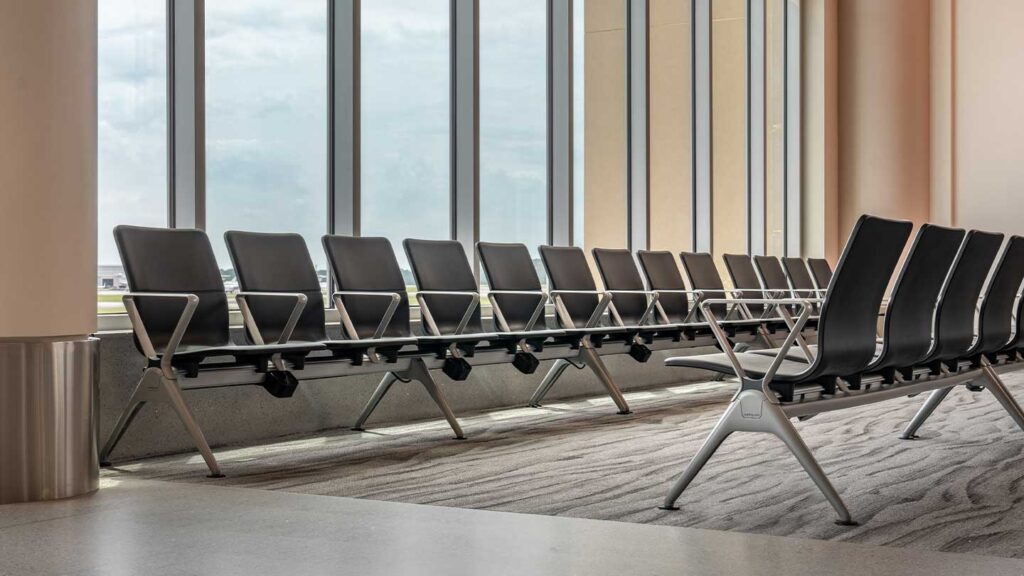Airports are among the busiest and most dynamic public spaces in the world. Every day, millions of travelers pass through terminals, each bringing unique expectations, habits, and needs. To create seating that supports comfort, efficiency, and well-being, designers and manufacturers must pay close attention to how passengers actually behave. From solo business travelers needing quiet workspaces to families looking for comfortable spots to gather, patterns of use and behavior directly shape every aspect of airport seating design.
A leading airport seating manufacturer studies these behaviors closely, translating insights into seating solutions that balance function, aesthetics, and accessibility. Understanding these patterns is key to making design decisions that work in real-world settings rather than only looking good in blueprints.
Observing Patterns of Use
Passenger behavior studies start with observing how people interact with seating areas. Researchers look at questions such as:
- How long do passengers typically sit while waiting?
- Do they prefer sitting alone or in groups?
- How much space do they occupy with personal belongings?
- Do they use their time to rest, work, eat, or socialize?
These insights reveal that no single seating type suits all passengers equally. Business travelers often look for power outlets and quiet zones where they can concentrate. Families need clusters of seats with extra room for strollers and luggage. Older passengers appreciate seats with supportive backs and arms that make it easier to stand up.
Prioritizing Personal Space
One of the strongest influences on seating design is passengers’ desire for personal space. Even in crowded terminals, most people prefer not to sit directly next to strangers when they have other options. To accommodate this, manufacturers and designers:
- Leave space between individual seats or install armrests to define personal zones
- Create clusters of seating that allow small groups to sit together while maintaining distance from others
- Offer a variety of seating arrangements, including rows, pods, and lounge-style setups
These strategies help reduce discomfort and create an environment where passengers feel respected and relaxed.
Designing for Digital Devices
Today’s travelers rely on smartphones, tablets, and laptops throughout their journeys. Many passengers prefer to use waiting time for work or entertainment, so their behavior has driven a significant shift in seating design. Modern seating includes:
- Easily accessible power outlets and USB ports
- Small tables or arm surfaces to hold devices and refreshments
- Integrated lighting to improve visibility without disturbing neighbors
The ability to stay connected and productive has become an expectation rather than a luxury, making technology integration a top design priority.
Addressing the Need for Privacy
While airports are inherently public, passengers increasingly value opportunities for privacy. Whether making phone calls or simply enjoying a moment of quiet, travelers seek spaces that provide a buffer from crowds and noise. Seating manufacturers respond by creating:
- High-backed seats that shield users from visual distractions
- Modular partitions that define semi-private zones
- Seating pods and enclosed lounges for premium experiences
These options reflect an understanding of how personal comfort and privacy impact stress and satisfaction.
Supporting Mobility and Accessibility
Passenger behavior also varies by age and physical ability. Older adults, parents with small children, and travelers with disabilities often have specific needs. Observations show that:
- Many passengers struggle with low seating that makes standing up difficult
- Travelers using mobility devices need clear space and easy access to seats
- Families often spread out over multiple seats, requiring flexible layouts
Manufacturers address these findings with solutions such as:
- Higher seat heights and supportive armrests
- Spaces reserved for wheelchairs and companion seating
- Configurations that allow seating clusters to adapt to group needs
By considering diverse passenger behaviors, designers create inclusive environments where everyone can feel comfortable.
Considering Cultural Influences
Cultural expectations also shape how passengers use seating. In some regions, communal seating is more accepted, while in others, people expect more individual space and defined boundaries. Manufacturers offer modular designs with customizable layouts so airports can reflect local preferences and cultural norms.
Responding to Changing Travel Trends
Finally, travel behavior is not static. Events such as the rise of remote work, changes in airline operations, and even global health crises shift how people use airport spaces. For example:
- Increased remote work means more passengers expect work-friendly seating.
- Health concerns have created higher expectations for spacing and hygiene.
- Longer layovers due to security or scheduling changes mean passengers spend more time in terminals.
Flexible seating systems allow airports to respond to these evolving behaviors without major renovations.
Conclusion
Passenger behavior is the foundation of successful airport seating design. By studying how travelers move, rest, work, and socialize, manufacturers develop solutions that meet real needs rather than assumptions. From accommodating technology use to providing personal space and supporting accessibility, every detail is influenced by observation and insight. As airports continue to adapt to changing travel patterns, understanding passenger behavior will remain essential to designing environments that feel welcoming, efficient, and human-centered.

